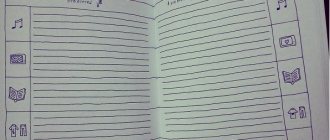Do you already know how to correctly write a defense speech for your thesis? If not, let's figure it out together.
A competent, clearly thought-out speech to defend your thesis project is an important component of success. It’s not enough just to write the text of a speech, you also need to be able to beautifully talk about your work. Otherwise, the commission may inadvertently get upset and lose all interest in you.
Fortunately, writing a speech for a thesis defense when there is a project itself is not so difficult. We have some tried and true tips from our contributors, and we're willing to share them free of charge.
Do you want more useful information and the latest news every day? Join us on telegram. And for those who want to spend time profitably, join the group.
Before writing a speech for a diploma: what to pay attention to
Before writing a speech to defend a diploma, a student must answer the following questions:
- How much time should I spend on the performance? (usually 7-10 minutes)
- What is the purpose of speech? What to tell the audience? Why is the work relevant?
- What prospects open up for researchers after a detailed study of the problems raised in the thesis?
In addition, it is necessary to study in detail the methodological recommendations of the student’s educational institution. It is in them that you can read important tips on how to correctly write a speech for a diploma.
Stages of preparing abstracts and speech text
Some of the most famous authors of textbooks on public speaking, Dale Carnegie and Heinz Lemmerman, are similar in their opinions regarding preparation for public speaking. They recommend setting aside enough time to gather the necessary material, think through the structure, and prepare for speaking in front of a specific audience. According to leading experts, it is important to pay attention to the following details, which we tried to arrange in order of priority:
| ✔ | Allow enough time (several days or even a week). During this time, try to prepare all the points of your speech and formulate its structure. To find fresh ideas, use various sources: look for something on the Internet, talk to friends, analyze different points of view, etc. Your speech should mature gradually. It is incredibly difficult to get all the essential facts into your speech half an hour before your speech. There is also a high chance that you may forget something, so preparing a speaker for a good speech should take quite a lot of time. |
| ✔ | Consider the interest of the audience. Of course, the success of your speech depends directly on how your audience receives it. No matter how beautifully you speak and no matter what important issues you consider, it is important that your listeners find it interesting and understandable what you are talking about. To do this, you need to know your future listeners: their interests, knowledge in this area, as well as everything that may influence their perception of your public speaking. The most important stage in preparing a speech is studying your audience. |
| ✔ | Set a goal, find an unsolved problem. It is important that your speech is certainly aimed at solving some task, problem, achieving a specific goal or even mission. If you just publicly express your thoughts on a certain topic, then people will not be interested in listening to you. Try to talk about the solution to a specific current problem that worries your listeners - this will arouse genuine interest in your speech. |
| ✔ | Collect and write down all the material that you can find on your topic. This will help you not miss anything. Keep a notepad, text file or note in your smartphone or tablet, which will always be at hand in order to write down a fresh thought. You can also use quick (scanning) reading techniques if you need to collect material in the shortest possible time. A good speech depends largely on your good understanding of the topic of the story. The audience immediately feels and recognizes how competent you are in what you are talking about, and even if you are not very skillful in presenting the material, but you are talking about interesting and rare things, this can often save the situation. Having good knowledge in the area of your speech is already half the battle. |
| ✔ | Use your own thoughts. The true preparation for a speech lies in the fact that all the collected material (opinions, theses) must be passed through oneself and form one’s own position. In this case, your speech will sound more natural, in addition, it will be easier to remember your own thoughts, but to do this, you first need to formulate them intelligently. It is better to do this during preparation, rather than formulate thoughts spontaneously during the introduction. |
| ✔ | Gain backup knowledge. Study a little more material than you need for the presentation. This will help you feel confident and will also allow you to easily answer all questions and counter comments from listeners after or during the speech. Reserve knowledge is psychological preparation for a performance . This technique is used by many politicians, journalists, and tour guides. Some skilled speakers deliberately leave certain information unsaid in their speech, on the one hand, in order to concentrate on what is more important, on the other hand, on the other hand, to provoke a question from the audience and then answer it brilliantly. |
A good illustration on the topic of preparing a speech:
Create a structure (plan) for your speech. If you have spent enough time and effort collecting the necessary materials, then most likely all of them will not fit into your speech. Therefore, the next stage of preparing your speech should be structuring the information received. To create a good speech, you need to select the most important points and, based on them, create a plan for your speech.
In the next lesson you will find the necessary recommendations and techniques for the best structuring of your speech. In addition, a good frame for your theses will be various techniques that better clarify your thoughts and create a certain perception of your speech by the audience. You can learn about these techniques in one of the following lessons of this training.
Structure of a defense speech for a thesis
Like any speech, a speech to defend a diploma has its own structure:
- The introduction contains an appeal to the members of the commission, voicing the topic of the thesis and its relevance. It is also necessary to highlight the purpose of the work, main tasks, subject and object of research. You can start it with the words: “Dear Chairman and members of the State Certification Commission! We present to your attention a work on the topic...”.
- The main part contains a description of the structural parts of the diploma. The beginning could be like this: “This work has a traditional structure and includes: an introduction, three chapters of the main part, a conclusion, a list of references and appendices.” It makes sense to pay special attention to project activities and the research methods that the student used in his work. Independent conclusions, analysis of theoretical foundations, the ability to highlight the main thing from the flow of information - all this is important to reflect in the main part of the speech.
- The conclusion contains the main conclusions, the results of the work done and determines the practical (applied) benefit of this research. At the end, you need to thank the audience for their attention to the report.
The speech for the thesis can be illustrated with visual slides. To do this, it is good to prepare a presentation using Microsoft Power Point. It should be bright, memorable, contain little text and a lot of pictures, graphs and other illustrations. Calm, soft colors and memorable images are the key to a successful diploma presentation!
Do you need to prepare for a performance if you have the ability to improvise?
People are divided into several categories:
- on those who do not mince words;
- for those who have difficulty finding words;
- on those whose eloquence depends on the situation.
The most eloquent people are certainly more likely to give a good speech spontaneously, but even they cannot always count on success if they have to improvise in front of an unfamiliar audience, answering unexpected questions. Even famous showmen, who have a lot of looseness, a sense of humor and a vocabulary, claim that the best improvisation is prepared improvisation.
It will be a great idea to prepare jokes, witticisms, answers to tricky questions so that they seem to have been born during the performance itself and spontaneously uttered. But not a single experienced speaker will dare to let this matter take its course, and we do not advise you to do so.
The main mistakes students make when writing a speech for their thesis
Typical mistakes when writing a speech for a thesis include:
- Too many words . The student simply will not be able to complete the allotted 5-10 minutes.
- Dry and full of terminology speech . Confusing phrases, adverbial phrases, and an excess of terms make it difficult to reproduce.
- Use of personal pronouns (“I”, “we”). It is necessary to replace “I studied” or “we studied” with “it was studied in the work.”
- Emphasis on theory . The theoretical foundations of the topic should be touched upon minimally, the main attention should be paid to your own conclusions and practical research.
- Attention to detail . If one aspect of the work is presented in great detail, it is difficult to present the entire work.
- Extra information . Everything that is not related to the topic of the diploma must be mercilessly removed!
- Replacing the results with a new question . If a new question is raised at the end of the thesis speech, the committee members will get the impression that the work is not finished and the student has not achieved the goal.
What else should you consider when preparing to speak in public?
Before you utter your first words, a certain opinion has already been formed about you. The fact that people are greeted by appearance has not yet been canceled. Therefore, it will not be superfluous to get yourself in order, relax, and dress appropriately. Clothing should match your status and occasion.
Many women intuitively know what can be worn and what should be left for another time. But still, do not hesitate to seek advice from a stylist-image maker, especially if your career is at stake.
Speaking in front of a large audience is an excellent chance to express yourself, and you should not miss it. If you prepare well for giving a speech, this event will not become a nightmare memory for you, but quite the opposite. It is possible that over time you will even enjoy speaking in public. Eloquence to you and responsive listeners!
Share
- 1
Tips for writing a commencement speech
So, here are practical recommendations on how to prepare a good speech for your thesis defense:
- Write your own thesis . Even if you did not write the thesis yourself, it is worth writing a student’s speech to defend his thesis after thoroughly studying the research work itself. Re-read the material, let it “settle” in your head. After this, you can begin to write the words of the report.
- Remember the time . Typically, the thesis defense does not last long (10-15 minutes). You should not directly rewrite the entire thesis into your speech. Let the report be an assistant, a cheat sheet that will make it easier to talk about the research.
- Think through possible questions . Before writing a security statement for your thesis, together with your supervisor, try to anticipate the questions that the venerable commission may ask. Information that will help with answers can be included in the speech in advance.
- Use information from the introduction and conclusion . Indicate what the task of the diploma was, how it was solved, what they did and what they received in the end. It's important to convey the essence of your work in your speech, so add conclusions from each chapter.
- Rehearse your defense in front of a mirror . Or in front of friends. Standing in front of the commission, you will not feel much discomfort, since you have already been in this situation “at rehearsal.” In addition, this way you can tailor your opening statement to a clearly defined time frame.
- To make a presentation . And here it is important to know how to properly prepare a presentation for your thesis defense.
Before writing a speech to defend your thesis, look at an example of a successful speech on special resources so as not to look stupid.
By the way! For our readers there is now a 10% discount on any type of work
Examples and samples of speechwriting
To make it clearer to you how the above is applied in practice, let's look at a couple of examples of successful matches.
No matter how much people mocked Sasha Spielberg on the Internet, her speech for State Duma deputies was composed quite competently. It is immediately obvious that she did not work on it herself.
And this is an example of speech taken from the site myspeechwriting.ru. Look at how simple the language the author uses. This text is very easy to learn and convenient to pronounce out loud.
What's wrong with "Hello, my name is..."
Most speakers don't like introductions.
Often at the beginning the speaker feels awkward and does not know how to introduce the topic. The default phrase appears: “Good afternoon, my name is... for the last 15 years I have been doing... and today I will tell you how...”. For the listener, the introduction is a promise that something interesting will happen next. Therefore, the task of the first minutes of the speech is to interest and inspire confidence. The phrase “Hello, my name is...” is usually repeated from speaker to speaker and does not help to capture attention.
Here are some more stamps for introductions:
- How can you hear me?
- Let's find out who's in the room today. Raise your hand those who...
- I rarely perform, so I worry. Clap for me so I won't be scared.
- Usually what I will tell you now is what I say in a three-day training. Today we only have 30 minutes, so let's not waste time.
- All these techniques are neutral in themselves, but due to frequent repetitions they have turned into information noise. The audience ignores them, and you lose important minutes of the first impression.
Now imagine that after several identical introductions, the speaker suddenly begins his speech with a personal story or case that the listeners will be interested in telling their friends. Coming up with such moves is not easy, so the trainers have made a selection of tools for introductions.
Play a short video
Imagine: you start your presentation to the production department with a video in which satisfied customers give a positive review of your product. Or you open a fundraising event for endangered species with a mini-film about the Amur leopard and its offspring.
The video evokes an emotional response. Unlike words and slides, a short film engages the audience more easily, adds drama and quickly conveys the essence of what is happening.
What techniques do you use? Share in the comments.
Start with a quote
Usually, when talking about a quote, school traumas come to mind. But the source of citation can be not only Aristotle or Socrates. Take the statement of Dudya, Varlamov, Lebedev. Quote a well-known expert in your field or a member of your team if this is a local meeting.
To be honest, this technique is so rare that we couldn’t even find a good example. Therefore, we recommend hiring you as soon as possible. And if you come across a video where the speaker starts with a quote, share it in the comments.
Start with an affirmation
The technique of starting a speech with the main idea of the speech is rare in Russia. Instead of greeting, try to immediately start with the essence - a capacious statement that you will further expand on.
For example, Mikhail Kazinik began his TED talk with the phrase “Listen, school is dead. And if the new school is not revived, then you can prepare for the third world war.” Two techniques work in parallel here: the speaker immerses listeners in the context and differentiates himself from other speakers.
Speech by Mikhail Kazinik at TEDxSadovoeRing
Checking equipment before the report
At any decent conference, speakers are asked in advance (on the day of the talk or even the previous day) to check that their flash drive, laptop, and other equipment they need is compatible with the equipment provided by the conference organizers.
In the case of defending a thesis, this will be a banal check that the cathedral projector connects normally to your laptop and displays the picture in the resolution that you need. Be sure to check that all programs that you will use during the report (xterm, exceed, Adobe Reader, OpenOffice Impress, etc.) show what you need, in the required resolution and without shifts on the screen. Even experienced presenters get confused when the most interesting part of the window is off the screen.
Make sure the computer you are using to show your slides can read what you have them on.
These rules seem obvious, but dozens of people (including myself) have regularly felt uncomfortable in front of listeners over such little things.
How to warm up your voice
Before you start warming up your voice, you need to stretch your vocal cords. To do this, gently press on the larynx with your thumb, and then breathe deeply into the diaphragm . How do you know if you are breathing from your diaphragm? Place your hand between your chest and stomach, then take a short breath and exhale slowly. This is similar to when we, having experienced relief, exhale in a relaxed manner, “phew.”
- By the way, such breathing is an effective technique for eliminating anxiety. As soon as you feel fear or tension, take a short breath, then exhale smoothly and you will feel much better.
Now you can move on to warming up your voice. Where do we start here? For example, from the “Om” exercise. To do this, place your hand on your head and begin to continuously pronounce the sound Om. Try to expand the volume of the larynx as much as possible until you feel vibration in your hand.
It is also good to draw out the vowels “i”, “e”, “a”, “o”, “u” (in that order and for as long as possible). Their alternate pronunciation activates blood circulation in the neck and chest. You can enhance the effect of stretching vowels if you add the “Tarzan” exercise and start beating yourself in the chest with your fist. This will not only clear the bronchi, but will also energize you before the performance.
Thus, by breathing diaphragmatically, you fill your voice with volume and strength, and by stretching the vowels, you improve its sound. However, how you sound depends largely on how you handle diction. Therefore, we move on to working on speech clarity.
How to improve your diction
The simplest and most effective way to improve diction and give clarity to speech is well known to us since childhood. These are all kinds of tongue twisters. However, it is important for us, as speakers, to be able to pronounce them in one breath. For example, I like these:
Margarita collected daisies on the grass. Margarita lost her daisies, but not all of them.
Queen Clara severely punished Charles for stealing coral.
The bull was blunt-lipped, the bull was blunt-lipped, the bull's white lip was dull.
Tell us about your purchases. What about purchases? About shopping, about shopping, about your purchases.
The king is an eagle (must be repeated quickly several times).
In the shallows we lazily caught burbot, You exchanged the burbot for tench. Was it not you who sweetly begged me for love, And beckoned me into the mists of the estuary?
Next, you should stretch your speech apparatus. To do this, you can move your lower jaw, like a shelf, pushing it forward and back, and also, stretching your lips, rotate them clockwise and counterclockwise. You can improve the mobility of your tongue by sticking it out and moving it up and down, then sideways and in a circle, as well as “brushing” your teeth with it inside and out.
Thus , before starting your speech, you must:
- Remove anxiety by working on your body and breathing through your diaphragm.
- Warm up your voice by stretching your vocal cords and stretching your vowels.
- Work on your diction using tongue twisters and warming up your speech apparatus.
Voice the statistics
A bold statement containing statistical data is ideal for persuading the audience to listen to your recommendations and follow them in the future. The main thing is that these numbers are directly related to the main message of your speech.
For example, the vice president of sales for a leading US healthcare company successfully markets hospital software using this method. She begins with dry but impressive numbers: “Medical errors have become the third leading cause of death after heart disease and cancer. We are talking about 400 thousand cases a year. This is much more than previously thought. We want to create a world without medical errors, and we need your help."
Questions during the report
Rule seven: the speaker is the master of his time
Decide in advance whether you can be interrupted with questions during the report. If you do not have a known high authority among the audience, if you are afraid of losing your thoughts, if you are uncomfortable going away from the topic of the report, ask all questions to be written down at the beginning of the report and asked at the end. This can be explained in different ways: from “I’m a crazy control freak and I can’t vouch for myself” to “today I want to tell you a lot of interesting things, and if we interrupt often, we may not have time.”
In order not to go beyond the rules, be sure to ask one of the organizers to keep track of the time and give you a signal ten and five minutes before the end. At many conferences, for this purpose, a timer is placed in front of the speaker with his back to the hall, which shows how much time is left until the end of the report. At worst, a smartphone or watch placed in front of you will do, but so that it can be seen from where you walk during the report.
It can be simpler: if sometimes you look at your watch to check if you are talking, no one will be offended, although they may think that you are late for the train.
It is good practice to leave about five minutes at the end of the report for questions; if you told something interesting to the audience, and it does not take place in China, you will definitely be asked questions. In China and some other Asian countries, it is not customary to ask questions publicly, and you can tell the audience that after the report you will be drinking tea in a cafe around the corner, and if anyone wants to clarify anything, you will be happy to do so over a cup of tea .
Rule Eight: Maintain composure and a sense of humor
Who likes it when everyone laughs at him? Therefore, if you find yourself in a funny situation during a public speech, treat it with detachment, with humor, and laugh yourself. Stumbled and broke a chair on stage? It doesn’t matter, remember “damn it” from “The Diamond Arm” or some one close to the audience and you’ll have a relevant joke.
The main thing is to observe moderation in everything. If you came out in a dirty suit and had to shake yourself off on stage, don’t spend the entire report nervously removing specks of dust from your jacket; If you put a stain on your tie before a performance and you don’t have time to wipe it off, act as if the stain isn’t there. There is absolutely no need to make fun of yourself throughout the entire report on this matter - after all, if the report is interesting, everyone is looking at your mouth or eyes, and not at your tie.
Important detail
The report cannot be read from a piece of paper.
If you want to come across as an energetic and successful speaker, read the report from memory. Looking at a cheat sheet two or three times in half an hour is not a sin, but reading the entire report from a piece of paper is a disaster! The cheat sheet should look decent (a pack of two A4 sheets in your hand, I think, looks neutral, but a piece of paper clutched in your fist looks suspicious). And now, patient reader, you can vote for the article - and thereby hint to the author whether he should prepare future articles - about how to get out of difficult situations during reports, about how to make slides, and about how to correctly write a resume and cover letter if you want to work in a Western company.
UPD:
thank you golodnyj for the note on the font size on the slides: the correct minimum size that is normally visible in the room is not 14, as I initially wrote, but 30. In my presentations there were up to 24, but in such cases I didn’t like myself for it. It's better to stick to 30 point.
Types of public speaking
Currently, several types of public speaking are known.
1. Lecture
This type of public speaking is known to everyone. This is communication with the audience by reading previously prepared material on one, maximum two topics. It is understood that during a lecture, its listeners listen to the lecturer presenting material that is new to them.
The lecture can also be conducted in the form of a dialogue with the audience. During this form of lecture, the lecturer’s monologue is replaced by an active dialogue with the audience. This is the most interesting form of lecture, which is actively used by professors during the educational process in higher educational institutions.
2. Scientific discussion
This form of public speaking is usually devoted to discussing a scientific discovery on a specific topic or discussing the defense of a dissertation at any level, from undergraduate to doctoral. Here hypotheses are put forward and their relevance is proven or disputed.
3. Report
In this case, a monologue is also implied, at the end of which a scientific discussion is possible.
4. Public lecture
This is an open event at which the lecturer presents a specific topic, and all those present can ask questions they have about the topic of the lecture.
It should be noted that recently a new form of homework in schools, colleges and universities, in the form of public speaking, has become especially popular. By doing such homework, schoolchildren and students practice relevant skills, getting rid of all sorts of communication complexes inherent in a large number of people.
How to relieve tension
Emotional stress always manifests itself in the body and the easiest way to eliminate it is by working with the body. By removing the body clamp, you will free yourself from the emotions that bind you inside. How to do it? Alternating tension and relaxation in the body. For example, you can stand in such a stance, inhale and tense your whole body as much as possible, and then, slowly exhaling, gradually relax it. You will feel the tension go away as you exhale. Let's try to do this right now.
If you have internal fear, then you need to shake yourself with all your might from fear, then relax, repeating this several times. Well, my favorite remedy is shoulder massage. Now stand behind each other, put your hands on your neighbor’s shoulders and begin to knead them. Now switch places and give pleasure to the one who massaged you. Did you feel a surge of calm and relaxation? Great, then let's move on.
Show a powerful photo
A picture is worth a thousand words. And maybe more. So whenever possible, use pictures instead of text. A high-quality photo will make it easier to understand, capture the imagination of the audience and make the report more memorable.
For example, the president of an electrical equipment sales company skillfully inspired his managers to cut costs. Instead of showing them the usual charts, graphs and tables, he opened the meeting with a rather strange question: “Why did the Titanic sink?”
Everyone responded in unison about hitting an iceberg. Then the head of the company displayed an image of an iceberg on the general screen: its tip was visible above the water, but a much larger part was hidden under the surface. “The same thing awaits our company. Hidden costs are the very underwater danger that will drag us to the bottom.” This visual metaphor inspired managers, and their savings proposals ultimately saved millions of dollars.
Give the participants a task
The format of the task can also seem bullshit - it immediately seems that you are asking listeners to stand up and start exchanging business cards or hugs. In fact, the task is soft and does not require active action from the listeners. For example, show a picture and ask to guess what it is. Or offer a choice between two options.
Memory champion Joshua Faure began his presentation with a simple task: close his eyes and imagine everything he was saying. Faure offered unexpected and absurd images: for example, Britney Spears dancing on your coffee table. In the middle of the speech, the speaker returned to this exercise - the audience remembered the strange images just as vividly 15 minutes later.
Presenter's pose
Mountains of text have been written and petabytes of video courses have been filmed regarding how and where a speaker should stand. For those who for some reason have not seen them yet - a short summary:
- stand in an open position, avoid crossing your arms over your chest, stomach and genitals;
- move freely around the space allocated to you in front of the audience (stage, part of the hall); avoid immobility;
- look into the hall, best of all, choose a person you like in the hall and look at him as if you were telling your report to him personally; it is better to choose several such people, and periodically look from one to another; Avoid constantly looking to the side, at the floor, at the ceiling. Thoughtful, looked out the window or to the side? This is normal, but there is no need to lose eye contact with the audience: return your gaze to the audience;
- never, you hear - never - read the slides. I myself have sometimes made this mistake, because if the slides are done well, there is always a temptation to sneak a peek at what to say next. A slide is not a prompter, it is an illustration of what you are telling. Reading the slides is bad manners. Try to recite the report from memory. You won’t tell your friend about a friendly drinking session while looking at your notebook, will you? So the report should pour out of you on its own, without hesitation or peeking. Believe me: the speaker reading the slides looks pathetic from the audience and evokes sympathy at best, and disgust at worst;
- Gesture - in Russia the audience will approve of moderate gestures. I mean polite gestures, of course. However, if you want to risk becoming a YouTube hero for an hour, you can show something indecent at a crowded conference. The scandal will be remembered by many, your name is not guaranteed. Do many people remember the name of the TV presenter who accidentally raised her middle finger when pronouncing the name of the US President? No, but the fact was remembered.
Tell a compelling story
Storytelling is one of the most powerful techniques. Since childhood, people love to listen and learn from stories. Fairy tale heroes, villains from campfire tales or theater characters captivate us with their dialogues, conflicts and destinies. With their help, we gain everyday experience and draw parallels with our own lives. Therefore, this technique easily holds the attention of any person.
Ideally, this should be a personal story that explains why you were puzzled by the topic of the report. Although a story about another person whom the audience might recognize would also work. Alternatively, uncover a fable, fairy tale, wisdom, or historical event.
The point is to captivate those present in 60–90 seconds and convey the key message of the entire subsequent report.
What problems did you (or someone else) encounter regarding the topic of the speech? How were they overcome? Who or what helped or hindered you? What conclusions were drawn? What should your audience get and feel after reading the story?







